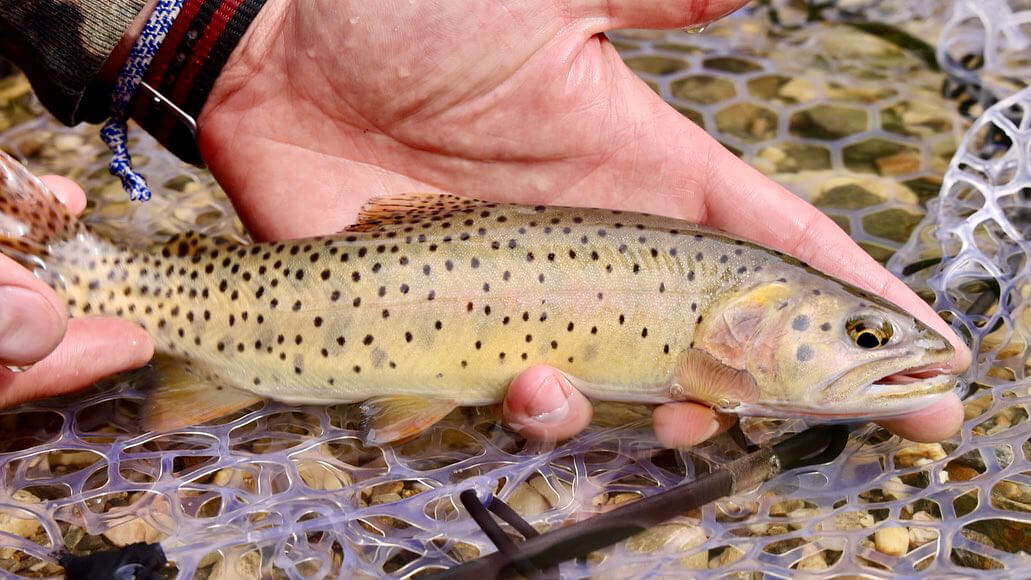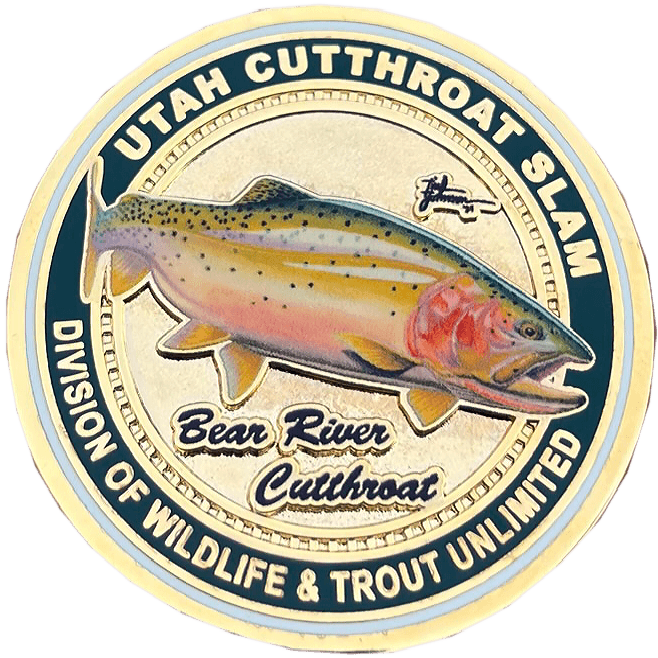
27 Mar Helpful Reminders for Proper Trout Handling
Written by Hayden Cook – Assistant Slam Director for Utah Trout Unlimited
The Utah Cutthroat Slam is an opportunity for anglers to embark on a fishing adventure while simultaneously supporting native trout conservation. For the Slam, one must catch all four of Utah’s native cutthroat subspecies: the Bonneville, Bear River, Colorado River, and Yellowstone cutthroat trout. The trek for these fish often takes anglers all across Utah to their native ranges, and while all forms of angling are acceptable for catching cutthroat, it is good to have reminders about proper fish handling techniques. From time to time we see some less than favorable ways people decide to present their fish in photo submissions, so this article will either serve as a reminder or first time education on some of the best ways we can protect our native cutthroat while fishing for them.
- Respect Regulations: Before diving into the actual handling of fish, it is important for each participant of the slam to familiarize themselves with the fishing regulations specific to each of the waters where these cutthroat reside. Some locations are catch-and-release only, while others require use of artificial lures or flies. Some locations may even be closed during certain times of the year to preserve spawning cutthroat, so ensure you take the time to read the Utah Fishing Regulations Guidebook for details regarding the lakes, rivers, and creeks you may be fishing for cutthroat in.
- Keep em’ Wet: Cutthroat trout are particularly sensitive to air exposure. So keeping them in the water as much as possible, especially after netting and while unhooking, is important. If you must handle them out of the water, do so swiftly and gently. Studies have shown quick intervals out of the water, around 10 seconds or so, have little effect on the trout. So removing the trout from the water for a quick photo is okay. But by the time fish have been out of the water for 30 seconds or more, mortality rates increase.
- Wet Your Hands: Wetting your hands before handling trout helps maintain the protective slime coat on their skin. This slime coat serves as a barrier against pathogens and infections on trout, and when they are handled with dry hands that coating can be easily removed. Similarly, using plastic or rubber coated nets can also help preserve their slime coat unlike traditional woven nets.
- Handle with Care: Support the trout by properly cradling its body. Avoid squeezing or gripping too tightly, as this can cause internal injuries. Keep fingers away from and do not stick them through the gills. And do NOT ‘lip” your trout. One of the saddest things we see is “lipping” of trout, which often damages or breaks their jaws and can ultimately kill the fish by affecting its ability to eat. Unlike warm water species like bass, trout jaws cannot be handled in this way, so handle them gently.
- Use Barbless Hooks: For anglers who want to go the extra mile, using barbless hooks will protect trout far more than using barbed ones. They make hook removal safer and less traumatic for the fish, and reduce potential injury and stress. We’ve all caught fish with damaged mouths, and this is likely the result of barbed hooks being removed in the past, so consider using barbless hooks to keep our native fish looking pretty. And on occasion, should a cutthroat swallow your fly or lure, a barbed hook could be a lost cause to remove without killing the trout. If you still plan to release the fish in this scenario, it is recommended to cut the line and let the fish go with the hook in place for best chances of survival.
- Avoid Dropping: Try to not drop trout. Even from a short height, a fall onto the ground or a rock can injure the fish or disrupt its equilibrium making it more vulnerable to predators or make it unable to swim properly. It is also best for trout to not be set on the dry ground or drug through the mud and dirt for the same reasons listed above (keep them wet and preserve their slime coat).
- Revive Before Release: If your trout appears exhausted after the fight of being caught, take time to revive it before releasing. Hold it in the water, facing into the current, and gently move it back and forth to help oxygenate its gills. Once the fish shows signs of vigor, let it swim away on its own. You can often tell once the fish is ready to go when it is willing to swim away and wants to get out of your hands.
- Proper Release: Release the trout gently into the water, facing upstream if possible. Allow it to swim away at its own pace, ensuring it has fully recovered from the encounter before moving on. Tossing fish into the water is certainly not a kind way to release trout and risks harming the fish, especially if it is a larger specimen. You may like to belly flop off the diving board, but cutthroat probably don’t.
- Be Mindful of Temperature: During warmer months, water temperatures can rise to levels that stress trout. Remember that trout are a cold water species, so water temperatures above ~65 degrees F are not ideal for their survival, and warm enough water temperatures can lead to trout mortality. So when fishing in hot weather, consider angling in the early morning or late evening when temperatures are cooler. You can even carry a small thermometer on your lanyard or in your bag for testing water temps on the go. Additionally, avoid handling trout excessively in warm conditions. Some places will even advise anglers to make fights with trout quick once you’re hooked up and releasing immediately to ensure minimal stress on the fish.
- Educate Others: Spread awareness about proper catch-and-release techniques among fellow anglers. By sharing knowledge and best practices in a polite and respectful manner, we can collectively ensure the conservation of cutthroat trout populations for future generations.
11. Clean our Waterways – Though it is not a trout handling tip, consider picking up trash you see while fishing. Old cans or bottles, fishing line, and any other garbage you see can be easily picked up and will help clean our public lands and ensure refuse is not ending up in the water where it may affect wildlife or water quality. One handy trick is to fill your net with trash as you walk back to the vehicle after fishing.
By following these guidelines, anglers participating in the Utah Cutthroat Slam can contribute to the conservation and preservation of native cutthroat trout populations. Let’s uphold the legacy of responsible angling and ensure these beautiful fish thrive in Utah’s waters for years to come. Visit the home page of our Utah Cutthroat Slam website for more details about the Slam and explore the subspecies pages to learn where to find each native cutthroat trout!

Sorry, the comment form is closed at this time.